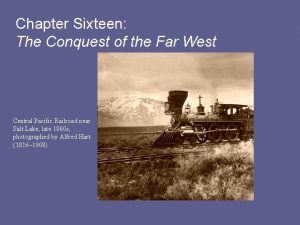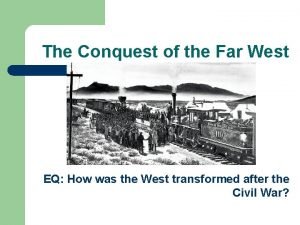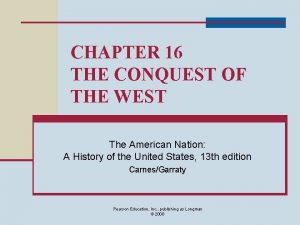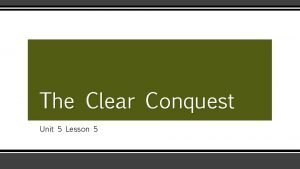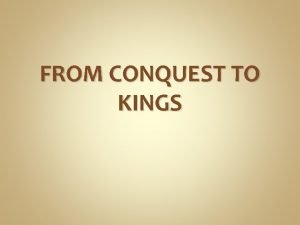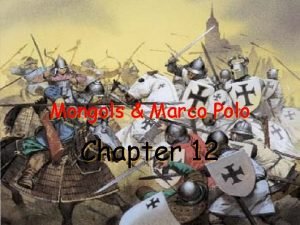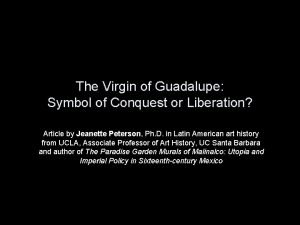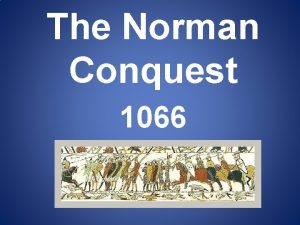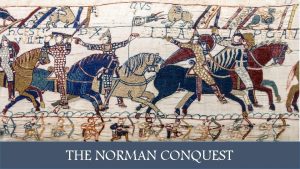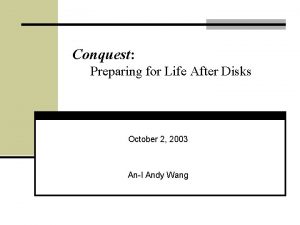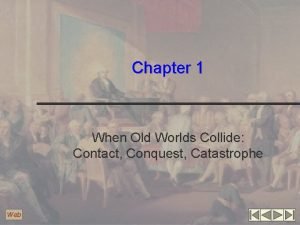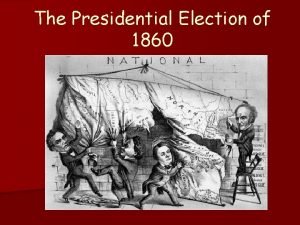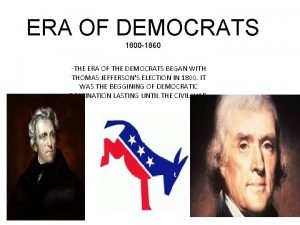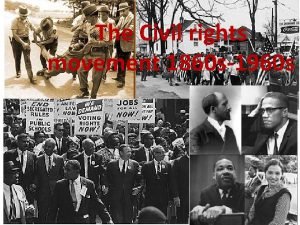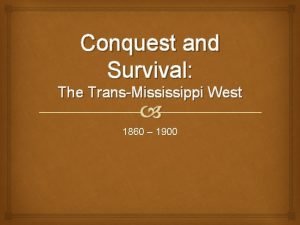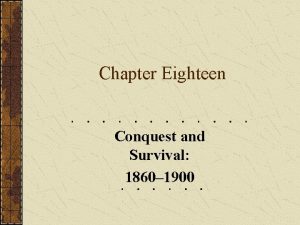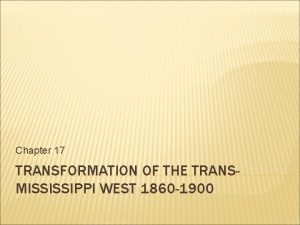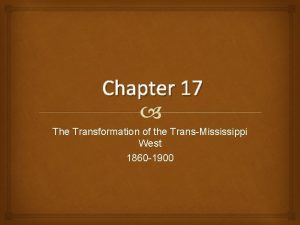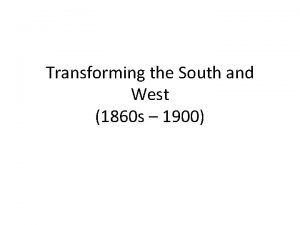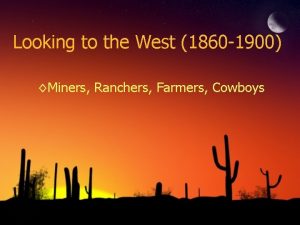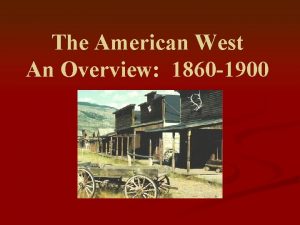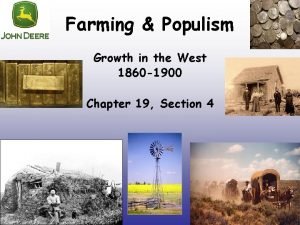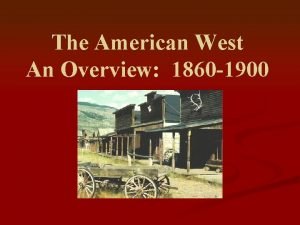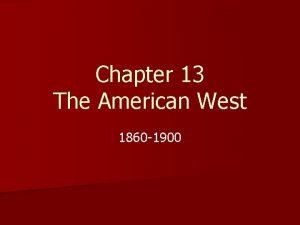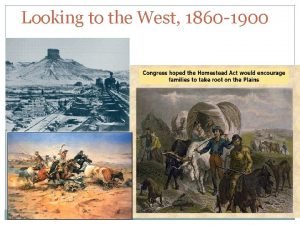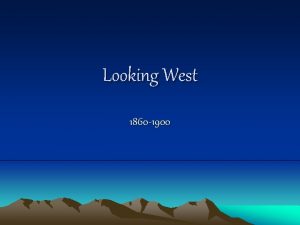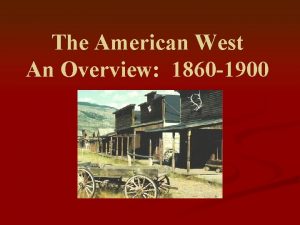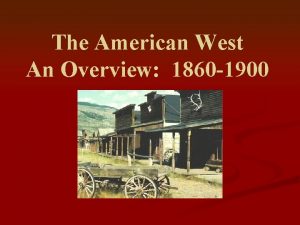Conquest and Survival The TransMississippi West 1860 1900

































- Slides: 33

Conquest and Survival: The Trans-Mississippi West 1860 – 1900

Indian Peoples Under Siege Indians had occupied the Plains for over 20, 000 yrs. , developing diverse ways of adapting to the environment Indians adapted to European ways: riding horses, guns; some converted to Christianity and learned English Legally tribes were supposed to be regarded as autonomous nations residing within the US, and though treaties were negotiated, force was often used instead

Reservations and the Slaughter of the Buffalo The government had pressured Indian tribes to migrate West into a “permanent” Indian Territory, but Whites’ desire for land led the federal government to pressure western Indians to move to reservations Federal policies on reservations were inadequate to the needs of the tribes Nomadic tribes found their freedom disappearing as the buffalo were slaughtered by the railroad and overkilling by white hunters

The Indian Wars Sand Creek Massacre (Nov. 29, 1864): The Cheyenne led by Chief Black Kettle were massacred by the US Cavalry (despite waving an American flag and signaling a truce) Great Sioux Wars (1865 -67): led by Sioux warrior Red Cloud, resulted in the Treaty of Ft. Laramie that allowed the Sioux to occupy the Black Hills GOLD in the Black Hills led settlers to invade the territory; the Sioux, Cheyenne, and the Arapaho united to defend their territory George Armstrong Custer and his regiment were wiped out by the largest assemblage of Indian warriors (2, 500 warriors) at the Battle of Little Big Horn (Custer’s Last Stand, June 25, 1876)


Chief Sitting Bull, the primary leader of the Sioux coalition at Little Big Horn became a main attraction of Buffalo Bill’s Wild West Show, before he was killed in 1890, in an arrest to prevent him from joining the Ghost Dance Movement

The Indian Wars, cont’d Chief Joseph and the Nez Perce: though originally cooperative with their removal, rebelled after several betrayals; the tribe was sent to a disease-ridden land in Kansas: “I shall fight no more, forever. ” Red River War (1874 -75): The Apache, Kiowa, and Comanche joined forces against the US Army in the Southwest (Arizona Territory); the fighting continued until Geronimo’s surrender in 1886—the last of the tribes to do so

Geronimo Chief Joseph

Sioux leaders (c. 1868) Red Cloud (one of the leaders of the Little Big Horn Battle) is seated center

The Mining Towns Mining fostered western expansion as gold and silver discoveries brought thousands of fortune seekers: California Gold Rush (1849); Comstock Lode in Nevada (1859); the Black Hills (1870 s)… Mining began as an individual enterprise, but because deeper mining required finance, special equipment, most fortunes went to corporations that bought out the smaller claims The western labor movement emerged in this rough and violent climate; unions refused to allow Black, Chinese, Mexican, and Indian workers membership Although many mining settlements were short-lived “Boomtowns” that were abandoned after the mines dried up, some would become permanent settlements—Unions were unable to stop owners from shutting down mines

The Mormons under Brigham Young had migrated into Utah in 1846, by 1870 over 87, 000 were living in the territory By the 1860 s into the 1870 s, the federal government began tightening control over the territory, and eventually banned polygamy and confiscated major assets to undermine the Mormon Church’s authority in the region The Mormon leaders obliged, and by 1890 officially denounced plural marriage, as their society began to resemble the very culture they wished to escape

Mexican Borderlands Under the Treaty of Guadalupe-Hidalgo, all Hispanics were formally guaranteed citizenship and the full rights of liberty and property However Whites and Hispanics clashed over control of the land As some Mexican elites were able to maintain their wealth and power, the majority of Mexicans found themselves trapped in poverty and turned to migratory work or moved to urban areas Mexicans were able to maintain their traditions and culture through continuous migrations into the 20 th century (Diaz’s Mexico, and the 1910 Revolution)

The Open Range The destruction of the buffalo opened the path for the western cattle industry The “long drive” saw cowboys rounding up herds for around $30 a month, living under the most harsh conditions: a roughly 1500 -mile trek with poor diet, no protection from the elements, and little to no rest Despite the “romantic image” of the West, 1/3 of all cowboys were Black, Mexican, or Indian

Cattle Towns Personal violence was commonplace in the cattle towns and mining camps: horse theft and cattle rustling was conveniently dealt with by lynching By the 1870 s, the “range wars” turned violent as farmers, sheep herders, and cattle ranchers battled over the same land—the “cattle barons” hired out mercenaries to deal with anyone who posed a problem By the end of the 1880, however the cattle business went bust: overstocking, overgrazing, and the winters of 188587 killed off 90% of the cattle, causing prices to plummet

The Homestead Act 1862: offered the incentive to prospective white farmers— gave 160 acres of land, had to live on the land improve upon it within 5 years Sparked the greatest migration in US history, and those who settled in the central and upper Midwest had the greatest successes due to climate and rich soil Only about 10% of farmers got their start under the act, as most bought their land outright (for a hefty price); land speculation rampant, and the railroads bought the rest —about half the homesteaders would lose their claims

Populating the Plains Railroads were the instrument by which the Plains were populated, delivering crops and cattle to eastern markets, and brought back goods to the settlers Since the railroads preceded settlement, they directly impacted the settlement of the West Professional promoters went to Europe and throughout the US recruiting settlers Immigrants formed tight-knit communities retaining their native languages and customs

The Soddy

Life on the Plains Farm families survived and prospered through hard work and community: all members of the family worked, tended to be seasonal, and dependence on neighbors for help with the hard work, tough soil, and the harsh climate Barter system developed among farmers due to lack of cash, not so much out of “being neighborly” Prepping the land was difficult due to the tough sod New technologies such as the singing plow and mechanical reaper made mass-farming possible Through federal aid, land grant colleges (Morrill Act, 1862), and federally-funded scientific research (Hatch Act, 1887) farmers were able to cultivate large-scale wheat production on the Great Plains

Producing for the Global Market Because of the new technologies, farmers adapted to produce for the cash market, rather than subsistence Wheat production became instrumental, as the Great Plains became the “World’s Breadbasket” Yet, startup costs for a farm kept homestead families in a cycle of debt, hence the well-capitalized, financed farmer had the advantage, turning farming into big business—small farmers became a part of their “bonanza farms”


California Agribusiness California led the way toward large-scale commercial farming that defined the “agribusiness” By 1900, CA had become the showcase for heavily capitalized farm factories employing large numbers of tenant farmers and migrants Fruit and vegetable growers (oranges, grapes, wine…) manipulated consumer tastes to create new markets for their products

Environmental Tolls Farmers destroyed existing plant and animal species and introduced new ones (buffalo, grizzlies, wolves – cattle and sheep) Due to the introduction of grazing animals, the grasslands and prairies were eaten away, making the soil vulnerable to erosion and the potential for huge dust storms Water supplies dwindled, natural lakes, springs, and rivers were diverted, dried up, and manipulated to suit commercial agriculture The federal government addressed these concerns and enacted many regulations to oversee the transformation of the land: Land Revision Act and Forest Management Act gave the president and federal government the power to reserve land from large-scale activities

Nature’s Majesty The Yosemite Act (1864) placing the area under the management of California 1872: Yellowstone becomes the first national park, five more would be established from 1890 -1910 Writers described the majestic quality of the American West, as landscape painters and photographers captured these images, tantalizing the public’s interest in the West


The Wild West More popular presentations emphasized the West as a source of “vigorous manhood” (TR) Dime novels portrayed the area in romantic and heroic terms: bold cowboys, savage Indians, noble farmers, corrupt cattle barons, exotic locations…these stories gave America its “mythology” Turner’s Thesis emphasized the settling of the West as instrumental to the development of the American character (individualism, innovation…) William Cody (Buffalo Bill) created a Wild West show that toured the country giving people a “recreation” of the West, staging famous reenactments of Little Big Horn, featuring the real Sitting Bull! Lewis Henry Morgan and Alice Cunningham Fletcher were two American “anthropologists” who helped pioneer a new science of cultural study as they sought to learn about the American Native—Fletcher would help found the American Anthropological Society and the American Folklore Society The Boy Scouts and Girl Scouts of America incorporated tribal lore to instill strength of character and an uniquely “American” sentimentality

Sitting Bull and Buffalo Bill

Reform Policy and Politics Reformers advocated assimilation and eradication of tribal customs (Bureau of Indian Affairs) The Dawes Severalty Act (1887) sought to destroy tribal sovereignty Individuals were granted land if they chose to sever themselves from their tribe Indian religions and ceremonies were banned, along with the telling of myths Indian schools forbade traditional clothing, language, and body fashions: “kill and Indian, save a man”

Wounded Knee An Indian prophet Wovoka had a divine vision that said judgment was coming and that the Sioux needed to practice the Ghost Dance The Ghost Dance was not tolerated among white settlers, who were freaked out by the natives dancing to exhaustion (Sitting Bull was killed over a misunderstanding at the Pine Ridge Reservation) December 29, 1890: after an accidental misfire, over 200 Indians were massacred at Wounded Knee Creek by automatic weapons, even though they had agreed to surrender; soldiers left them to die in the cold





Endurance and Rejuvenation Tribes that survived were those living on unwanted land (Navajo and Hopi) Tribes became extinct, or have dwindled to the brink Northwestern tribes managed to adapt to the new situations and remain relatively isolated to survive And though the traditional ways of life are for the most part gone, the resurgence of Indian sovereignty would rise again decades later
 The conquest of the far west
The conquest of the far west The conquest of the far west
The conquest of the far west Chapter 16 the conquest of the far west
Chapter 16 the conquest of the far west State of survival survival of the fittest tweak
State of survival survival of the fittest tweak State of survival survival of the fittest stages
State of survival survival of the fittest stages Cycle of conquest and colonization
Cycle of conquest and colonization Spanish exploration and conquest apush
Spanish exploration and conquest apush Chapter 12: religion, romanticism, and reform, 1800–1860
Chapter 12: religion, romanticism, and reform, 1800–1860 American reform movements between 1820 and 1860
American reform movements between 1820 and 1860 The clear conquest
The clear conquest Qing conquest of the ming
Qing conquest of the ming Mingoch
Mingoch Joshua describes the conquest of canaan
Joshua describes the conquest of canaan Musique conquest of paradise
Musique conquest of paradise Conquest chapter 12
Conquest chapter 12 Symbol of conquest
Symbol of conquest Norman conquest quiz
Norman conquest quiz Birth of prince salim
Birth of prince salim Xoserve conquest
Xoserve conquest Norman conquest
Norman conquest Conquest
Conquest Conquest data disks
Conquest data disks Worlds apart conquest
Worlds apart conquest East is east and west is west
East is east and west is west Border states in 1860
Border states in 1860 Balais à tapis 1860
Balais à tapis 1860 American romantic period
American romantic period Election of 1860 definition
Election of 1860 definition Arthur and lewis tappan apush
Arthur and lewis tappan apush What era was the 1800
What era was the 1800 Decreto 1860 de 1994
Decreto 1860 de 1994 American romanticism 1800 to 1860 worksheet answers
American romanticism 1800 to 1860 worksheet answers South carolina 1860
South carolina 1860 1860
1860
